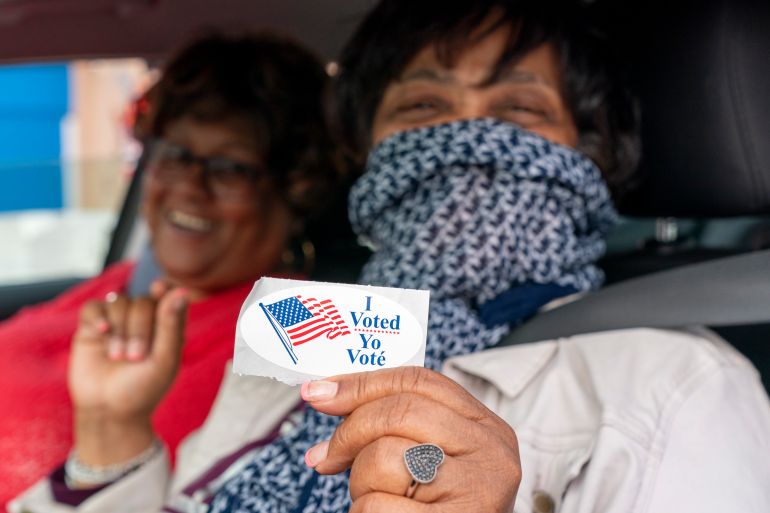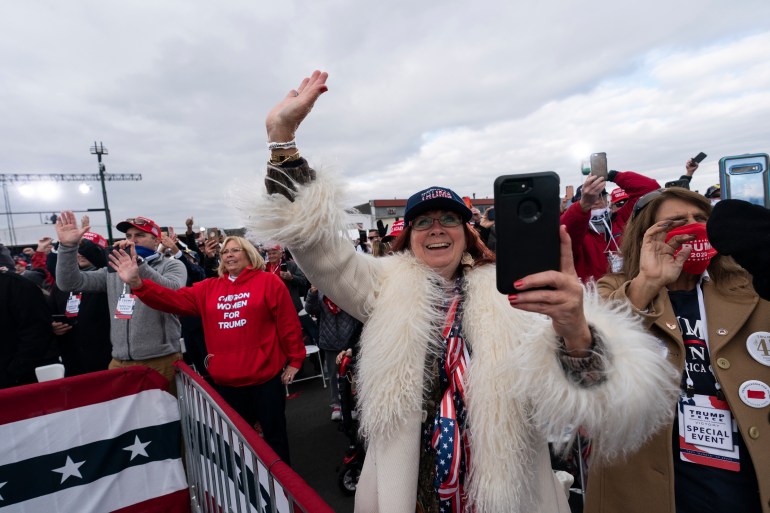US vote 2020: Why women decide elections
Women have voted at higher rates than men in every presidential election since 1980, making them a powerful force.

When some women gained the right to vote in the United States 100 years ago, men feared a “petticoat hierarchy” – where if women banded together to form their own parties, they could disrupt the country’s political system, according to Kathryn DePalo-Gould, a political science professor at Florida International University.
But that simply did not happen. The existing political parties quickly adapted to include women in their organisational structures. Many women cast their ballots for the same candidates as the men in their lives. It would be decades before women of colour – including Black, Indigenous, Asian American, and Latina women – were able to vote. And for women who could in 1920, many did not vote at all.
Keep reading
list of 4 itemsJoe Biden’s long political career features several policy shifts
US elections: Why the Senate contests matter
The 2020 US elections: A climate for change?
It was not until 1980 that a gender gap – the difference between the proportions of women and men who support a particular candidate – emerged in a presidential election. It was also the first year that women voted at higher rates than men. That trend has continued in every presidential election since then, and it is what makes women a powerful force at the ballot box today.
“Women voters decide elections,” DePalo-Gould told Al Jazeera.
Women, especially Black women, helped propel Barack Obama into the White House in 2008, and helped keep him there in 2012. In 2016, it was the votes of white, suburban women that gained much attention. While more women voted for Democratic nominee Hillary Clinton, Donald Trump won among white women, especially suburban women in states where the president triumphed by just a few thousand votes.
The suburban voter
Turning to this year, the white, suburban female demographic will again likely play a decisive role.
“There’s enough [women] that can swing” the vote, DePalo-Gould explained. “If Trump doesn’t win white women, he has to make it up somewhere else.”
In a poll published by CNN earlier this week, Democratic nominee Joe Biden led Trump, 61 to 37 percent nationally among women. The gap is in part driven by college-educated, white women, some of whom voted for the president in 2016, but are turning on him this year. Where Trump does hang on to some support, according to polls, is among white women without college degrees. What matters most, however, is how the candidates fare in swing states, and that is why campaigns are seeking to appeal to suburban women in these key, battleground areas.
Trump has taken to pleading for white, suburban women’s votes. “I saved your damn neighbourhood, okay?” he told suburban women in Pennsylvania earlier this month, playing up his “law and order” messaging. While in Michigan on Tuesday, he leaned on the sexist and outdated appeal, “We’re getting your husbands back to work.”

Biden, meanwhile, has focused on how he would respond differently to the coronavirus pandemic, which has disproportionately affected women across the US. Biden also chose Senator Kamala Harris as his running mate, making her the first Black woman and Asian American on a presidential ticket.
The attention on suburban women has many in these areas feeling the increased significance of their votes. Maria Moller moved to Pennsylvania’s Lancaster County, an historically Republican bastion, from Georgia last year.
Having been a lifelong Republican, the 49-year-old switched her voter registration to “Democrat” after moving to Pennsylvania, which went for the president in 2016. She said she “regretted” voting for Trump four years ago, and has wanted him out of office ever since.
“I want to flip Pennsylvania,” she said, adding that she is looking forward to voting for Biden on November 3.
“I really do feel that my vote and my daughter’s are going to count,” Moller told Al Jazeera. “Trump was here, just two miles away, it shows my vote is really going to count.”
Alice Butler-Short, who lives in Fairfax County, Virginia, says she too knows the importance of women in this election.
Butler-Short created Virginia Women For Trump, which is not directly affiliated with the campaign, ahead of the 2016 election, knowing the president would need women’s support.
“At that time, I actually knew it was going to be a movement because I knew that women would be a huge part of the campaign to get him elected,” she told Al Jazeera.
“I think women really are the strength of the country in many ways,” she said. “Women are uninhibited when it comes to campaigning.”
Butler-Short says she disagrees with the notion that suburban women are turning against Trump.
“Suburban women love this president,” she said. “They’re the mothers. They’re the homemakers, They’re the people who want safety for their families. They want prosperity for their families. They want security for their families,” she added. “That is in the forefront of his policies: law and order.”
Women of colour: A growing, reliable force
But it is not just white women who will be a powerful force this year. Black women, despite voter suppression laws, have voted at higher rates than other groups in recent presidential elections, including in 2008 and 2012, and advocacy groups say they are especially enthusiastic in 2020.
According to a recent Higher Heights for America survey of 506 likely 2020 Black women voters, 75 percent said they were more motivated than ever to cast their ballots this year. About 64 percent of those surveyed said Black women, who make up the Democratic Party’s most loyal base, will make the biggest difference to the outcome of the presidential election if they turn out in significant numbers.
“Black women are a consistent, growing and reliable voting bloc,” said Glynda Carr, the president and CEO of Higher Heights for America, a political action committee dedicated to electing more progressive Black women.
“They have a long history of organising their house, their block, their church, their sorority, their union, which makes them the most powerful voting bloc,” Carr told Al Jazeera, saying their reliability stems from the fact that they are “issue voters,” motivated by an array of issues, including education, healthcare, the economy and racial disparities.

“In this cycle, not only are we seeing the unleashing of Black women’s individual and collective organising power to vote up and down the ballot, but also but having the presence of a Black woman in Kamala Harris right at the top of the ticket as a running mate is creating the enthusiasm that we haven’t seen since a Barack Obama’s historic win,” she added.
Although 98 percent of Black women voted for Clinton in 2016, turnout was lower than in previous presidential elections, including in key battleground states where Trump won by small margins.
The 2016 election “was probably like a ‘wow’ moment for women,” said Christian Nunes, the president of National Organization for Women (NOW), the largest organisation of feminist grassroots activists in the US.
She pointed to the first Women’s March, which saw nearly half a million in Washington, DC, and millions more worldwide march against President Trump on the day after his election. The “Women’s March activated a lot of women,” Nunes said. “It was kind of like a solidifying place for a lot of women and a place of solidarity.”
While voter turnout was down in 2016, men and women turned out at record rates in the 2018 midterm elections. This was especially true for women of colour. That surge helped elect a record number of women to Congress, including the most diverse congressional classes ever. It also helped the Democrats regain control of the House of Representatives – a feat the party and its supporters are hoping to repeat in the Senate this year.
‘Women do the work’
Whether it is at the federal, state or local levels, women can be seen at the forefront of this year’s campaigns.
Women have already contributed a record $1.6bn this election cycle, according to the nonpartisan Center for Responsive Politics, which also found that 43 percent of political donors in the 2020 cycle are women, the highest percentage on record.
Women are again running for office in record numbers. In 2020, 298 women are candidates for the US House, up 27.4 percent from 2018, according to the Center for American Women and Politics. That includes a record 115 women of colour.
And if polling is any indication, this year is on track to see the widest gender gap ever.
Despite the progress, women remain underrepresented in government – a reality that many women’s groups say will continue to drive their fight well beyond election day.
“Women do the work. Why aren’t we represented by our government,” said Adora Jenkins, the brand and communications managing director for Supermajority, a women’s rights advocacy group founded in 2019.
“In the months post-election, our job is to hold every office accountable to our agenda to ensure that women are not only counted and have a seat at the table, but our lives, experiences and voices are centred and so that policies and rules are made that reflect more than half the population that we make up,” Jenkins told Al Jazeera.
Until then, however, Supermajority, Higher Heights for America, NOW and other similar groups are focused on making sure women can, and do get to the polls this year.
“We [women] are a majority … and we can determine the future of this country,” Jenkins said.
